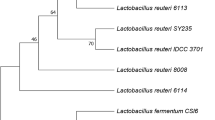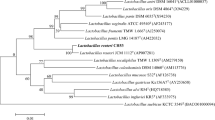Abstract
3-Hydroxypropionaldehyde (3-HPA) produced by Lactobacillus reuteri is a broad-spectrum antimicrobial substance of glycerol conversion. The aim of the present work was to optimize 3-HPA production by Lb. reuteri ATCC 53608 using a two-step process. The first step was the production of Lb. reuteri cells in optimal conditions. Cells were then harvested by centrifugation and suspended in glycerol solution, which the resting cells bioconverted to 3-HPA. The effect of biomass concentration, temperature, glycerol concentration, anaerobic/micro-aerophilic conditions, and incubation time was studied for high 3-HPA production. 3-HPA accumulation was limited by the death of cells in contact with high concentrations of 3-HPA. However, a very high 3-HPA concentration of 235±3 mM was obtained after 45 min of incubation at 30°C in 400 mM glycerol for an initial free-cell concentration of 1.6±0.3×1010 viable cells/ml. A high viability was maintained at low temperatures in the range 5–15°C, but with a slightly lower yield of 3-HPA at 5°C compared with higher temperatures, up to 37°C. Successive 1-h incubations of Lb. reuteri cells in 200 mM glycerol at 15°C to tentatively reuse the cells resulted in decreasing 3-HPA concentrations at the end of each cycle, with two successful production cycles yielding high 3-HPA concentrations of 147±1 mM and 128±2 mM.





Similar content being viewed by others
References
Axelsson LT, Chung TC, Dobrogosz WJ, Lindgren SE (1989) Production of a broad spectrum antimicrobial substance by Lactobacillus reuteri. Microb Ecol Health Dis 2:131–136
Casas IA, Dobrogosz WJ (2000) Validation of the probiotic concept: Lactobacillus reuteri confers broad-spectrum protection against disease in humans and animals. Microb Ecol Health Dis 12:247–285
Chen CN, Sung HW, Liang HF, Chang WH (2002) Feasibility study using a natural compound (reuterin) produced by Lactobacillus reuteri in sterilizing and crosslinking biological tissues. J Biomed Mater Res 61:360–369
Circle SJ, Stone L, Boruff CS (1945) Acrolein determination by means of tryptophane. Ind Eng Chem 17:259–262
Doleyres Y, Fliss I, Lacroix C (2004) Increased stress tolerance of lactic acid bacteria produced during continuous mixed-strain immobilized-cell fermentation. J Appl Microbiol 97:527–539
El-Ziney MG, Arneborg N, Uyttendaele M, Debevere J, Jakobsen M (1998) Characterization of growth and metabolite production of Lactobacillus reuteri during glucose/glycerol cofermentation in batch and continuous cultures. Biotechnol Lett 20:913–916
Font de Valdez G, Ragout A, Bruno-Bárcena JM, Diekmann H, Siñeriz F (1997) Shifts in pH affect the maltose/glycerol co-fermentation by Lactobacillus reuteri. Biotechnol Lett 19:645–649
Honda S, Toraya T, Fukui S (1980) In situ reactivation of glycerol-inactivated coenzyme B-12-dependant enzymes, glycerol dehydratase and diol dehydratase. J Bacteriol 143:1458–1465
Kajiura H, Mori K, Tobimatsu T, Toraya T (2001) Characterization and mechanism of action of a reactivating factor for adenosylcobalamin-dependent glycerol dehydratase. J Biol Chem 276:36514–36519
Knietsch A, Bowien S, Whited G, Gottschalk G, Daniel R (2003) Identification and characterization of coenzyme B12-dependent glycerol dehydratase- and diol dehydratase-encoding genes from metagenomic DNA libraries derived from enrichment cultures. Appl Environ Microbiol 69:3048–3060
Lacroix C, Grattepanche F, Doleyres Y, Bergmaier D (2005) Immobilized cell technologies for the dairy industry. In: Nevidovic V, Willaert R (eds) Applications of cell immobilisation biotechnology. (Focus in biotechnology) vol 8B. Springer, Berlin Heidelberg New York, in press
Lüthi-Peng Q, Dileme FB, Puhan Z (2002a) Effect of glucose on glycerol bioconversion by Lactobacillus reuteri. Appl Microbiol Biotechnol 59:289–296
Lüthi-Peng Q, Schärer S, Puhan Z (2002b) Production and stability of 3-hydroxypropionaldehyde in Lactobacillus reuteri. Appl Microbiol Biotechnol 60:73–80
Man JC de, Rogosa M, Sharpe ME (1960) A medium for the cultivation of lactobacilli. J Appl Bacteriol 23:130–135
Smiley KL, Sobolov M (1962) A cobamide-requiring glycerol dehydrase from an acrolein-forming Lactobacillus. Arch Biochem Biophys 97:538–543
Sung HW, Chen CN, Liang HF, Hong MH (2003) A natural compound (reuterin) produced by Lactobacillus reuteri for biological-tissue fixation. Biomaterials 24:1335–1347
Talarico TL, Dobrogosz WJ (1989) Chemical characterization of an antimicrobial substance produced by Lactobacillus reuteri. Antimicrob Agents Chemother 33:674–679
Talarico TL, Dobrogosz WJ (1990) Purification and characterization of glycerol dehydratase from Lactobacillus reuteri. Appl Environ Microbiol 56:1195–1197
Talarico TL, Casas IA, Chung TC, Dobrogosz WJ (1988) Production and isolation of reuterin, a growth inhibitor produced by Lactobacillus reuteri. Antimicrob Agents Chemother 32:1854–1858
Vollenweider S, Lacroix C (2004) 3-Hydropropionaldehyde: applications and perspectives of biotechnological production. Appl Microbiol Biotechnol 64:16–27
Vollenweider S, Grassi G, König I, Puhan Z (2003) Purification and structural characterization of 3-hydroxypropionaldehyde and its derivatives. J Agric Food Chem 51:3287–3293
Author information
Authors and Affiliations
Corresponding author
Rights and permissions
About this article
Cite this article
Doleyres, Y., Beck, P., Vollenweider, S. et al. Production of 3-hydroxypropionaldehyde using a two-step process with Lactobacillus reuteri . Appl Microbiol Biotechnol 68, 467–474 (2005). https://doi.org/10.1007/s00253-005-1895-4
Received:
Revised:
Accepted:
Published:
Issue Date:
DOI: https://doi.org/10.1007/s00253-005-1895-4




